Black Holes And Dark Matter Pictures And Dozens Of Facts About Space And The Solar System [PHOTOS]
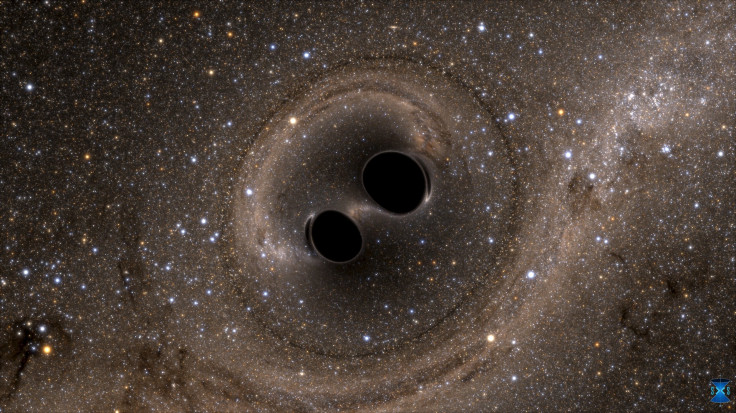

This question originally appeared on Quora. Answer by Eric Morrison.
1. Dark Matter and Dark Energy
95% of the universe is composed of a combination of dark matter (27%) and dark energy (68%) respectively, with "normal matter" (the stuff we see) only accounting for 5% of the universe. This means if you were to remove everything you can see and interact with in the visible universe (people, food, home appliances, planets, stars, galaxies, nebulae, etc.), there would still be 95% of the universe remaining! The result is that there is more dark matter and dark energy in the room you are currently in than normal matter. It is percolating through your body as you read this answer!
The general rule is that dark matter holds galaxies together and dark energy drives the expansion of the universe. It is the ultimate tug of war. At the beginning of the universe, dark matter was much more powerful than dark energy, which is what allowed early galaxies to form. But dark energy has now taken over and is causing distant galaxies to recede from us at a rate faster than the speed of light. As you may know, no object with mass can exceed the speed of light, however there is no limit on the speed at which the spacetime medium (which contains all objects) may expand. As an aside, the only other "things" capable of exceeding the speed of light are shadows and tachyons. However, shadows do not violate any laws because they do not transfer information and are nothing more than the absence of light, and tachyons are hypothetical particles that are unlikely to ever be confirmed (sorry Tomorrowland).
In 100 billion years, as dark energy continues to push galaxies farther and farther away from us, observers living in our soon-to-be galaxy Milkomeda (a result of the merger between Andromeda and the Milky Way) will see nothing in the night sky except for our own galaxy. All other galaxies will have vanished because the light we would need to see them will not be able to catch up to us as the galaxies themselves will be moving faster than light. In that sad turn of events, all evidence for dark matter and dark energy will disappear because they will not see anything expanding. Even worse, they will have no evidence for the Big Bang. Those scientists will discover quantum mechanics, relativity, evolution, and almost all other forms of science, but even with the best telescopes and the best observations they can possibly make, they will come to a conclusion about the origin of the universe that is completely wrong. Their conclusion will be the existence of only one galaxy, surrounded by nothing but empty space, in a devoid, unchanging universe.
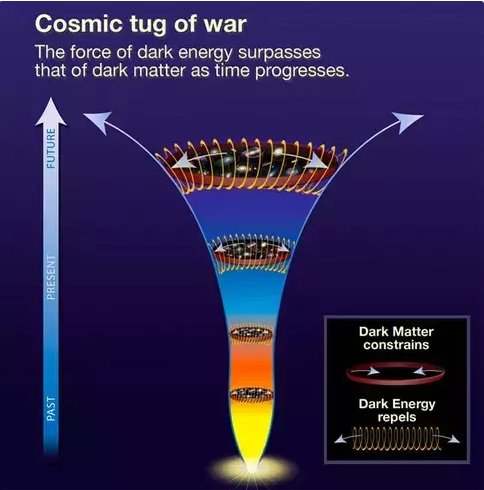
2. Shape of the Universe
The universe is most likely a closed torus shape, which solves the issue of whether the universe has an ending. A circle has no beginning or end: if you continue to travel in a straight line, you eventually make a circle and return to where you started; no walls or perimeters of the universe required. This is why the Romans considered triangles, squares, and circles divine: those shapes have no definitive beginning or end. Evidence for a closed, torus-shaped universe lies in the fact that light curves in a vacuum ever so slightly over vast distances, eventually forming a circle. Therefore, if you gazed out into the universe for long enough (billions of years), the light you see would eventually curve around the universe and you would see the back of your own head, similar to what happens when light orbits about the photon sphere of a black hole.

3. Blackholes, Magnetars, and other Cosmic Anomalies
Blackholes
You don't "see" blackholes because the light is busy orbiting the blackhole instead of going to your eyes, which is a testament to just how powerful the gravity of a blackhole is. Blackholes spend many years capturing stars and other light sources, technically making them one of the brightest objects in the universe! A strange irony indeed, yet you would never realize this until you entered one yourself! (enter a blackhole here ; notice how much brighter it becomes as you approach the singularity and how the light of the universe forms a circle around the blackhole).
In addition to the traditional stellar mass blackholes that form from collapsed stars, there are also rogue blackholes, which travel throughout the universe invisible and undetectable to us. We would not realize we were in danger of interacting with one until the orbits of the other planets started to mysteriously change. By that point, it would be too late for us to retaliate at all. Even if the blackhole did not venture anywhere near Earth, the mere altercation of the planetary orbits could spell disaster.
There are also supermassive blackholes, which are the blackholes that exist at the center of every galaxy and are an order of magnitude larger than stellar mass blackholes. The supermassive blackhole of the Milky Way galaxy is Sagittarius A*. One of the largest blackholes ever discovered was NGC 1277.
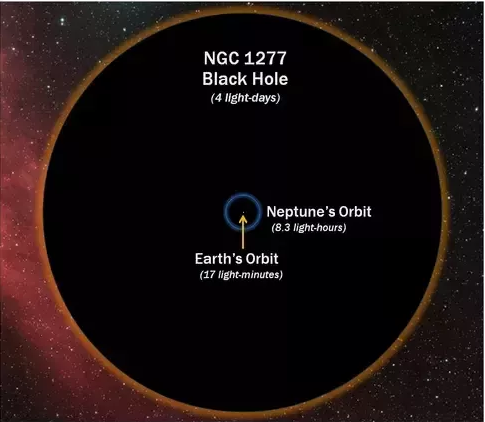
The blue ring in the image above is the full orbit of Neptune around the sun. Earth's entire orbit is a single dot. The blackhole's diameter is the distance between the Sun and Pluto, 9 times! A hypercompact stellar system is a supermassive blackhole that has gone rogue. None have been identified yet, but SDSS 1113 is the most likely candidate. If it does indeed turn out to be one, then that will prove that supermassive blackholes can exist outside of galaxies, and that is a frightening prospect to imagine.
Another type of blackhole is the non-rotating Reissner–Nordström blackhole, which may be safer to enter as you would not have to worry about being ripped apart by tidal forces. The same is somewhat true for supermassive black holes, except that you would feel the effects of tidal forces near the singularity, it would just take you a while to get there (a few hours).
Another type of blackhole are the primordial blackholes, which formed not from star collapses, but from the high densities present at the big bang. Further down where I discuss String Theory, I mention how current supermassive blackholes were most likely the original primordial blackholes. Having been around the longest, this would account for their enormous size.
The final type of blackhole, which was successfully created in a laboratory in 2009, is the sonic black hole. This is a blackhole in which sound cannot escape.
One proposed method for interstellar travel (which means between the stars, as opposed to intergalactic, which means between galaxies, or interplanetary, between the planets) is a ship called the Kugelblitz Drive. The proposed model would harvest the Hawking radiation emitted from the blackhole and use that as an energy source (here is a great article on how to do that).
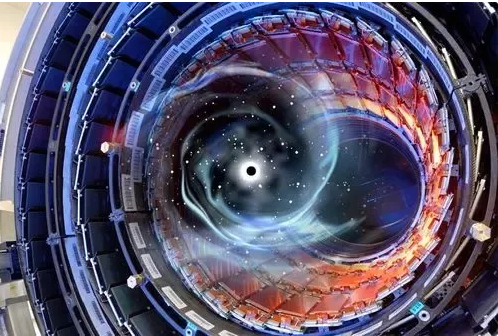
Neutron Stars
When stars collapse, one of three possible events occur: if the star is small, it will produce a supernova; if the star is medium size, it will form a neutron star; and if the star is large enough, it will collapse into a blackhole. Despite the mysterious nature of blackholes, the underlying physics involved with neutron stars is much more complex and fascinating.
Stars burn hydrogen and helium to fight against gravitational collapse. When a star exhausts its supply of fuel, it loses the fight and collapses. The next phase of protection against total gravitational collapse is neutron degeneracy pressure. The atoms can no longer win against gravity, and so now it's up to the neutrons. The electrons merge into the protons of atoms, leaving nothing but neutrons (the positive and negative charges cancel each other out). The neutrons become much more compacted, but they do not merge into each other because neutron degeneracy pressure prevents any two neutrons from occupying the same state.
Neutron stars are not typically larger than cities such as Manhattan, but their gravity is immense. The gravity of these mini leviathans is so powerful that none of the few hills that form on their surface exceed a few millimeters in height. If you were to walk across the surface of a neutron star and accidentally trip on one of these hills, you would fall towards the ground at upwards of 10,000 mph. You would become a meat smoothie almost instantaneously.
Furthermore, dropping a marshmallow on the surface of a neutron star at no higher than 1 meter would produce an impact so massive that it would hit with the force of at least 20 Hiroshima bombs. This is because the neutron star’s gravity accelerates inward falling objects to near the speed of light. It is worth mentioning that neutron stars also possess a photon sphere in which light orbits around it. To really drive the point home, a single teaspoon of neutron star weighs ~eight billion tons. If you attempted to hold a teaspoon of neutron star in an actual spoon, your arm would instantly be spaghettified and the neutron fragment would fall and impact the Earth with a force almost on par with the asteroid that wiped out the dinosaurs.
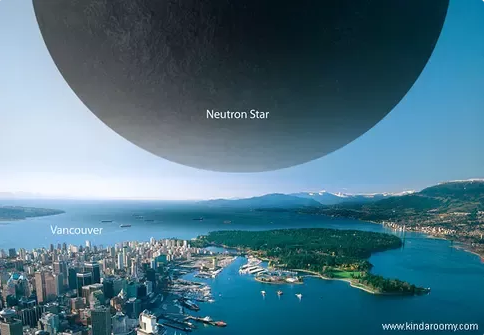
Neutron stars spin a few hundred times a second, equivalent to a kitchen blender. Pulsars are a type of neutron star that emit light at their poles and look like rapidly spinning lighthouses. The frequency at which these beams of light cross paths with the Earth is so precise and consistent that pulsar clocks have been created to keep a more accurate measurement of time, greatly surpassing the accuracy of pendulum and quartz clocks. Pulsar clocks are usually considered the most accurate clocks in the universe. However, sometimes the neutron stars will glitch due to starquakes, causing them to wobble and either speed up or slow down in their spinning. Now it is atomic clocks that keep the most accurate measurement of time. Regardless, when pulsars were first discovered, their high degree of precision and consistency were so bizarre to astronomers that they considered these rapidly blinking dots evidence of alien life.
As I said earlier, the physics of blackholes is simple relative to neutron stars. They involve little more than Newtonian and Einsteinian gravity. Conversely, neutron stars not only involve Einsteinian gravity, but also quantum mechanics, plasma physics, nuclear physics, and electromagnetism.
The crust of a neutron star is a thin layer of electrons and protons. Further down, the neutrons morph into odd shapes that are characteristic of pasta. The core of a neutron star is a complete mystery. Some think there is a quark-gluon plasma and others think it is exotic matter.
Magnetars
Many objects have a magnetic field, including humans (magnetoencephalography ) and the sun. The stars that become supernovas, neutron stars, and blackholes also have magnetic fields. In the case of neutron stars, the magnetic field of the original star is retained upon collapse. Since the star is compressed into a smaller volume, its magnetic field gets amplified.
The Earth has a magnetic field of 1 gauss. An MRI machine (Magnetic Resonance Imaging) utilizes 10,000 gauss. The strongest magnetic field ever produced on Earth was 100,000 gauss. Magnetars exhibit upwards of 1,000,000,000,000,000 gauss. We typically do not feel the effects of normal magnetic fields as they have little effect on our physiology. They alter compass needles, assist birds in migration, and shield the Earth from cosmic rays, funneling to the north and south poles to form the Aurora Borealis. But if you were 1,000 miles away from a magnetar, subject to a whopping quadrillion gauss, you would melt due to atoms in your body ripping apart. Keep in mind, an atom is a system in which a negatively charged electron orbits around a positively charged proton. Magnetic fields on Earth do not alter this arrangement, but in the vicinity of a magnetar, the electrons will actually divert course: their orbits will become elliptical, and then eventually needle like. All of the systems in your body will become disabled as matter essentially rearranges itself. Molecules will stop bonding and chemistry will stop working. For all intents and purposes, you will disintegrate at the subatomic level. So far, only 26 magnetars have been detected in the universe, including one near the supermassive blackhole of the Milky Way galaxy.
Quark star
A quark star is a hypothetical type of star that is theorized to exist at the center of a neutron star. Quarks are the smallest state of matter observed thus far. Combinations of up quarks and down quarks form all protons and neutrons in the universe. At the center of neutron stars where pressure is greatest, the neutrons themselves may be broken apart, causing a quark-nova, and leaving behind nothing more than a cluster of quarks. Neutron degeneracy pressure has failed and now it is up to quark degeneracy pressure. Any objects that overcome neutron, electron, and quark degeneracy pressure become blackholes. Collectively, this cluster of quarks is called quark matter. These up and down quarks may transform into strange quarks, leading to the formation of strange matter. 3C58 may be a possible quark star.
Credit goes to Paul Sutter for most of the information here on neutron stars and Magnetars
4. Star systems and planets
There are many different types of star systems and planets out there. I will cover a few here:
HD 140283 (also called the Methuselah star or “the impossible star") is the oldest known object in the universe. It has been estimated to be 14.5 billion years old, which is older than the universe itself (the universe is 13.8 billion years old). However, it has been allowed an 800 million year margin of error which would just allow it within the age of the universe.
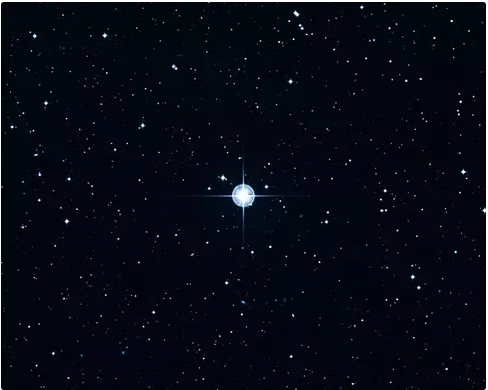
UY Scuti is the largest known star to date. If placed in the exact location of the sun, its surface would extend beyond the orbit of Jupiter. It would take over 1000 years to fly around this star once with a commercial airliner.
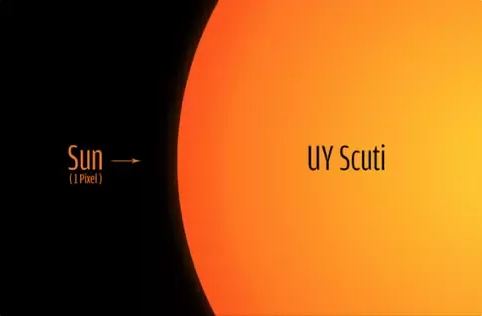
KIC 8462852 maybe home to an alien civilization. There are bizarre unexplainable dips in the planet's light with no recognizable cause. The alien civilization theory has little support, but I figure I will explain it here. There are 4 levels of technological prowess that a civilization can be measured in on the Kardashev Scale. Humanity currently measures in at around 0.72. A Type I civilization would be capable of controlling their entire planet including the weather, volcanoes, and the arrangement of landmasses via tectonic plate manipulation. A Type II civilization would be capable of harnessing the total energy of their star. Think how much heat (energy) is lost to the universe from the sun. Only a small fraction of the sun's energy strikes the Earth. A Type II civilization would use something analogous to a Dyson Sphere or Dyson Swarm to capture a much larger portion of the sun's energy. That energy could then used to power a Matrioshka Brain. This is what may exist at KIC 8462852.
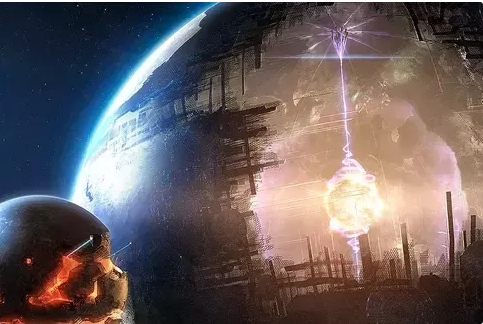
Albireo is a binary star system that contains one orange star and one blue star. Unfortunately, I did not find any information on whether this star system has exoplanets. If it did, the sky would be orange during the day, and blue during the night. I also searched through many other color contrasting binary star systems (red/green, yellow/blue, etc.) for exoplanets, all to no avail.
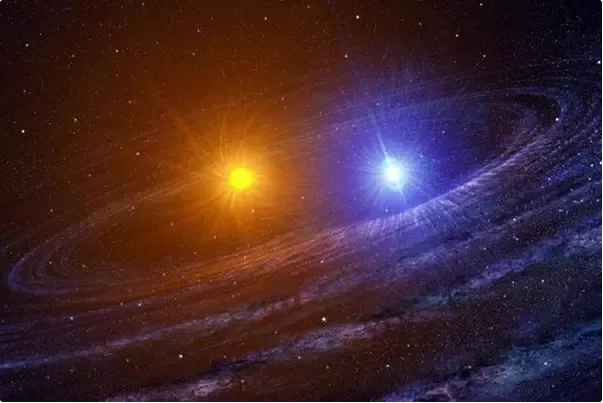
HD 188753 e is a planet in a triple star system , which means you would see 3 suns in the sky. There would rarely be night (if ever), you would have triple shadows, there would be constant solar eclipses, and you would always see a sunset no matter which direction you looked.
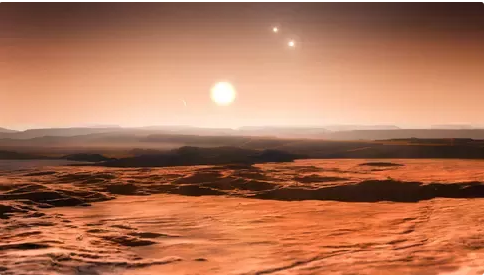
PH1b is an exoplanet that lives in a quadruple star system.
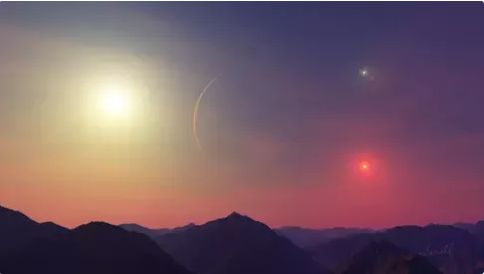
1SWASP J093010.78+533859.5 is a quintuple star system.
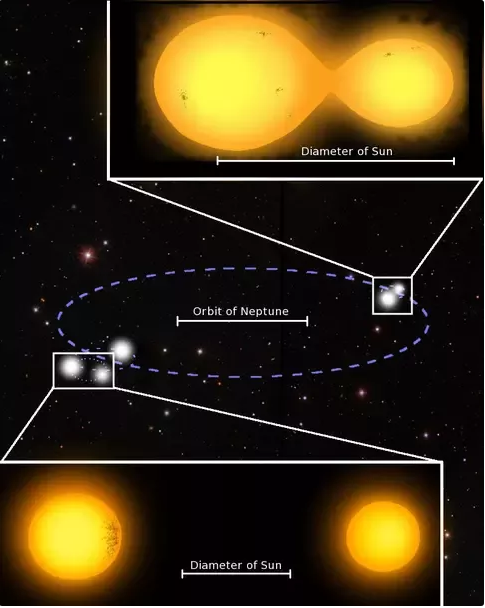
Castor is a sixtuplet star system.
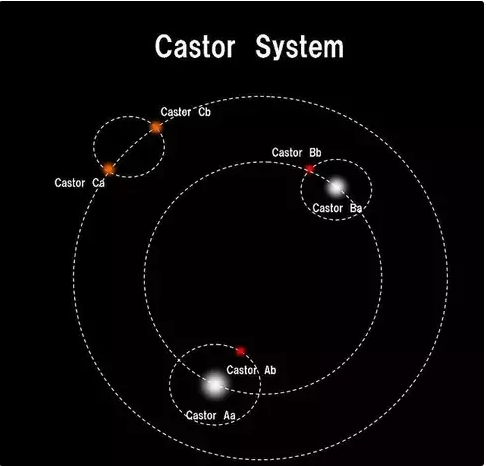
And finally, AR Cassiopeiae is a septuple star system, and so far the largest star system discovered to date.
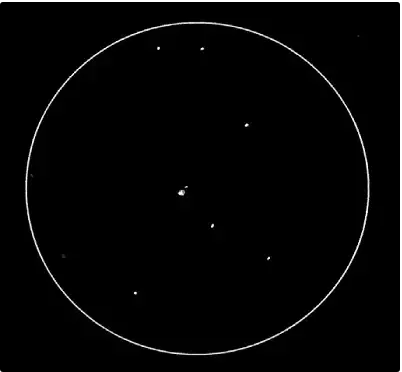
Eris is the second most distant object in the solar system at an estimated 96 AU from the sun (one AU is a measure of the distance from the sun to the Earth). Eris is sometimes called the tenth planet and is the ninth largest body in the solar system.
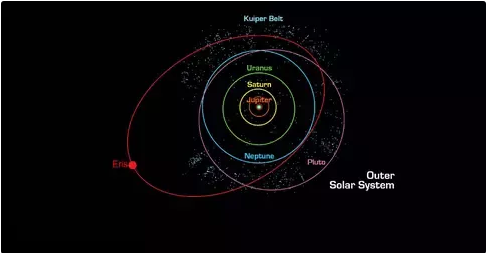
Sedna is the farthest object in the solar system with an aphelion at 937 AU.
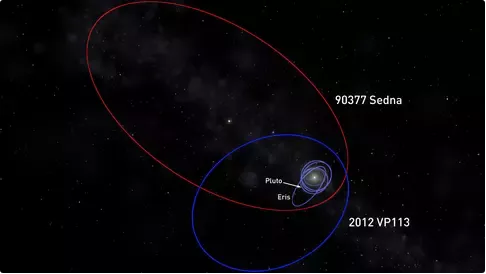
HD 106906B is the loneliest planet in the universe, orbiting its parent star at a distance of 650 AU, approximately 20 times greater than the space between the sun and neptune.
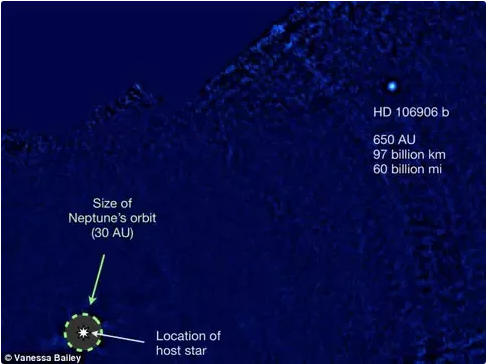
Phobetor was one of the first planets discovered outside the solar system and it is one of three planets orbiting around a pulsar. Its sun is basically a disco ball. I imagine the giant flash of light bathing the planet’s surface 161 times every second would make it very difficult to get sleep at night.
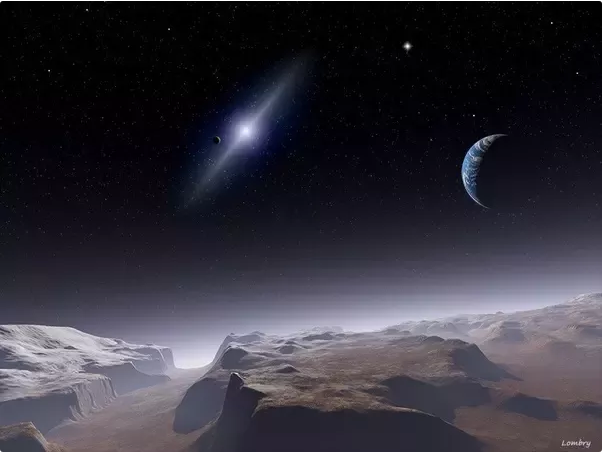
J1407B has planetary rings 200 times larger than saturn.

On HD 189773b , the planet rains glass sideways at 4ooo mph.
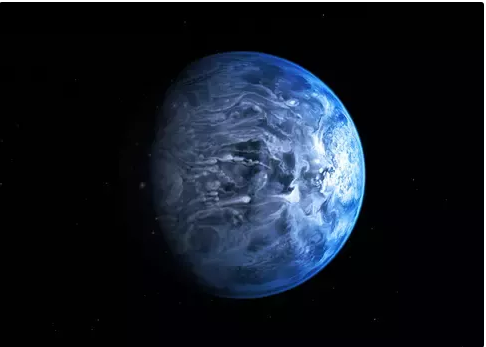
COROT-7 rains rocks that form in the atmosphere.
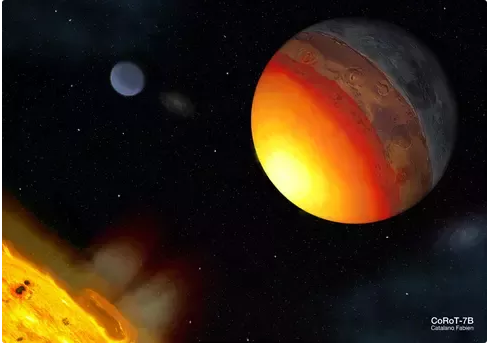
55 Cancri e is a planet made entirely of diamond. It is valued at 26.9 nonillion dollars, but on Earth, the diamonds would be worth less than dirt. This is due to basic demand and supply.
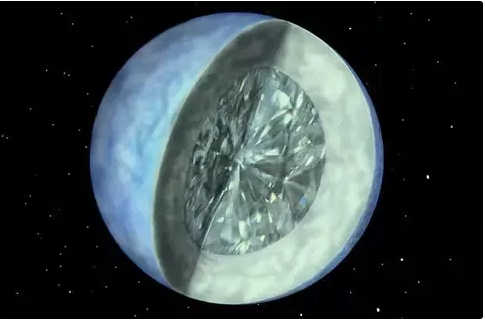
GJ 1214 b (also known as the "water world") is a planet entirely covered in oceans that are much deeper than the oceans on Earth. This planet may have been the inspiration for the water planet on the movie Interstellar. Some people claim we should be spending our money exploring the oceans rather than space, and while deep-sea bioluminescent and chemosynthetic creatures are fascinating, I think everything can be learned from the cosmos.

Gliese 436 b is a frozen planet so close to its parent star that its ice is on fire. The planet is so dense that despite the heat, the ice cannot melt and evaporate. Evaporation requires water molecules to expand and rise into the atmosphere, but the gravity of this planet is so powerful that the ice is confined to the surface, engulfed in a constant blaze.
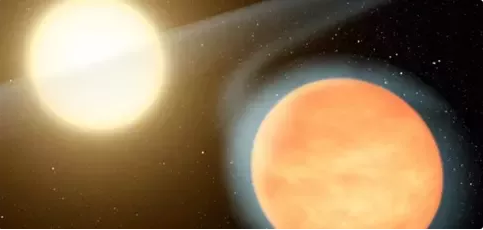
Upsilon Andromeda b is a planet in the Constellation of Andromeda that is completely frozen on one side (-230 °C) and molten lava on the other (1,650 °C). It is most likely tidally locked around its parent star.
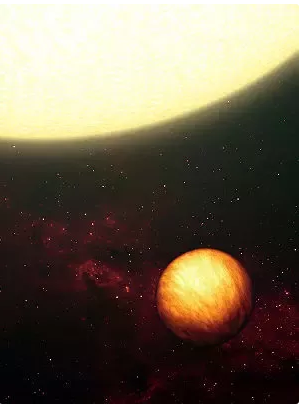
Gliese 581 c is similar to the above conditions of Upsilon Andromeda b except for the fact that it has a thin strip of land between the two extreme temperatures that can support life. The probability of life is so high here that a message was sent in 2008 and should reach the planet by the year 2029. This is the planet most likely to be colonized by humanity if we ever figure out interstellar travel. It closely orbits a red dwarf star that gives off primarily infrared light, meaning the sky will be red and the plants will be black.
Our sun gives off white light, which is just a combination of all the colors of visible light in the electromagnetic spectrum. On Earth, plants contain two primary types of chlorophyll that aid in photosynthesis and give them their green color: chlorophyll a and chlorophyll b. Chlorophyll a and b absorb red and blue light, and they reflect the green light back into your eyes, which is why they appear green. Green light is not at all used in photosynthesis. Plants also contain orange/red carotenoids that are masked by the abundance of chlorophyll during spring and summer. But when autumn arrives, photosynthesis ceases and the chlorophylls decay, exposing the carotenoids and causing the plants to look yellow, red, and orange. (I should mention that despite the fact that terra firma photosynthesis ceases, the Earth does not run out of oxygen during the winter months because 70% of the oxygen we get from photosynthesis is from algae in the ocean, and only 30% come from plants).
Now all of this occurs within visible light, from a sun that emits white light. On Gliese 581 c, the red dwarf primarily emits infrared light, which is just below visible light on the electromagnetic spectrum. Therefore plants would need to gather energy from infrared light in addition to visible light, which is only possible from Chlorophyll f. Chlorophyll f is the only known chlorophyll to utilize infrared light for energy, so plants with this pigment will be black. Colored light is not involved in the process and black is just the absence of color.
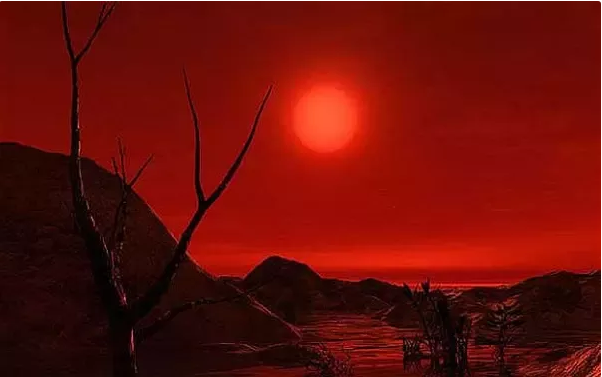
Kapteyn B is the oldest known potentially habitable planet at 11.5 billion years in age. If life formed early in this planet's history, it is likely far more advanced than humanity with at least a 4 billion year head start on evolution.
Europa is the 6th largest moon of Jupiter and may have an underground ocean.
Ganymede is the largest moon of Jupiter and may contain more water than all the oceans of Earth.
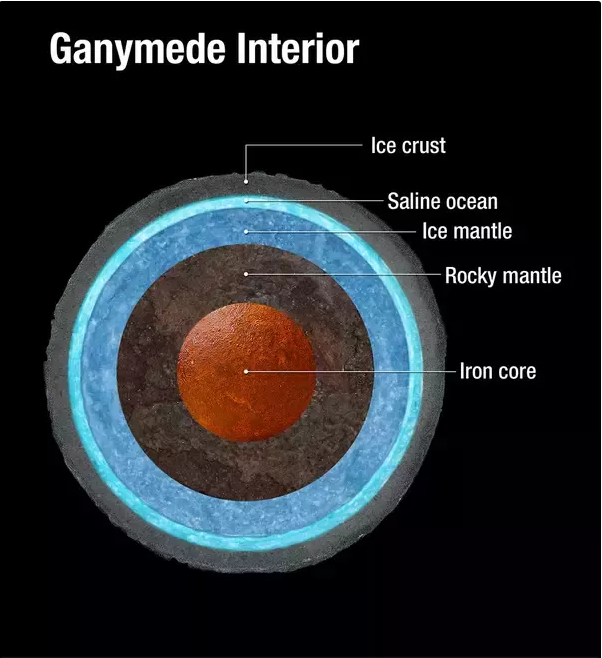
Saturn's largest moon Titan contains more oil than all of Earth. Resource scarcity is only an issue on Earth. Resources exist in near limitless quantities in the universe. As Neil DeGrasse Tyson correctly notes "You have people fighting wars over fossil fuels buried beneath the soils across a line in the sand. Meanwhile the universe has limitless sources of energy. We fight wars over access to minerals, yet the universe has an unlimited source of minerals." I find it deeply troubling that humanity has and continues to exhaust so much time, money, and lives to fight wars over resources on Earth when there exists an abundance of all resources in the universe including, water, oil, and land. In fact, there are so many habitable Earth-sized planets in the universe that every human, and every human who has ever lived, could live out their lives on their own personal world.
This would certainly be a good way to determine which economic system is most viable for the governance of humanity. Although, given the proliferation of automation and Ai, it would seem that humanity may be headed towards a resource-based economy. In our current monetary system, money is exchanged for the production of goods and services from other people. However, what are we to do when robots begin fulfilling these roles en masse? They will not require a salary, breaks or any leaves of absence, will not get tired or suffer from decreased productive output as time progresses, and the only cost to employers will be maintainence. Humans will be out of work and money will no longer serve a purpose. CPG Grey has an excellent video on the subject: Humans Need Not Apply
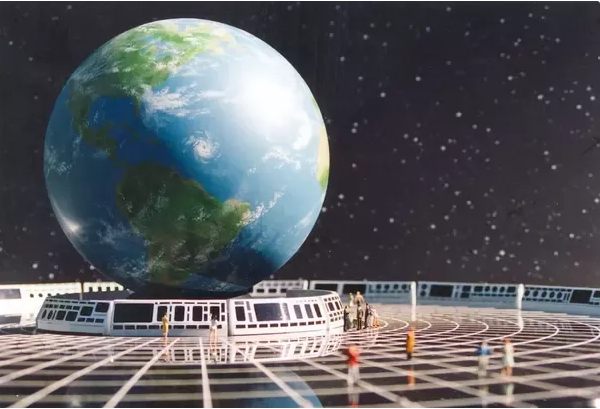
5. Elements and the Fundamental Forces of Nature
Elements and Atoms
Perhaps the most fundamental science of all disciplines is chemistry. It is sometimes considered the central science due to the many branches of science that rely on it. Biology and botany use it to understand photosynthesis and respiration, to create medicine, and to understand life. Astronomy and astrobiology uses it primarily in spectroscopy to determine the elemental composition of planets such as the ones featured above, and engineering uses it in materials science to determine the best elements to use for various purposes.
It all starts with the atom. To recap from earlier, and to delve a little deeper, an atom is simply what you call an electron orbiting around a central nucleus, which itself is composed of protons and neutrons that are bonded together. Each of these three components of the atom (proton, neutron, and electron) serve very distinct roles. When you gaze at the periodic table, you will notice many different elements including carbon, iron, and zinc. However, the names of these elements are arbitrary; for the only thing that separates them is the number of protons they have in their nucleus. We like to call atoms with two protons helium. If you were to add another proton, we would call that atom lithium. Add another and now it’s beryllium. The only difference between a carbon atom and an oxygen atom is that carbon has six protons and oxygen has eight.
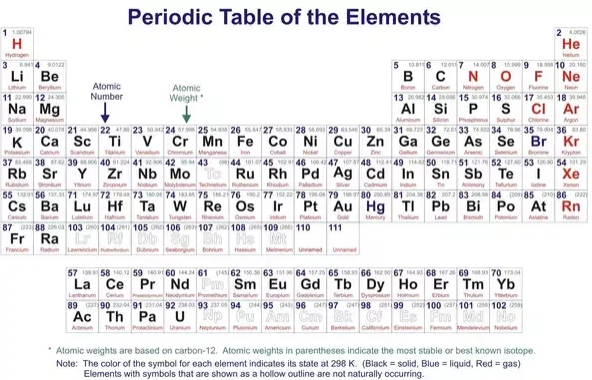
Aah the periodic table. Perhaps the most beautiful and useful creation in all of science. On it you will find information that relate to nearly every physical aspect of your existence, from the constituents of distant galaxies to the air you breathe.
While the number of protons determine which element an atom is, the number of neutrons determine the version of the element. Adding or removing protons will change one element into another, but adding or removing neutrons will change an element into a different version of itself. These different versions are called isotopes. Last but not least, the purpose of electrons is to balance the net charge of the atom. Protons have positive charges, neutrons have neutral charges, and electrons have negative charges. Natural elements have equal numbers of electrons (-) and protons (+) so that the final charge of the atom is 0. However, if you add or remove electrons from an atom, there becomes an imbalance between the charges and the atom becomes an ion. If you remove an electron, there are now more protons (+) than electrons (-) and so the atom’s (now called an ion) net charge becomes positive. A positive ion is called a cation. Alternatively, if you were to add an electron (-), there would now be more negative charges, and so the negative ion would be called an anion.
Forgive me if I appear to be underestimating your knowledge by providing such a detailed description of basic chemistry, but I think it is important to lay down this foundation so that the really interesting stuff becomes all the more fascinating in this context.
So we know electrons (-) orbit protons (+), but if electrons are negatively charged and protons are positively charged, and opposites attract, why don’t all electrons suddenly bind to all the protons? Well, the first thing to understand is that electrons do not orbit protons in the sense that moons orbit planets, planets orbit stars, or in the way ants engage in death spirals. Instead, electrons exist in a probability cloud of sorts where the probability of it appearing in a given location varies based on its distance from the nucleus. There are two primary features to understand about electrons in an atom: their momentum and their position. Heisenberg’s uncertainty principle states that the position and momentum of a particle cannot simultaneously be determined, and this becomes fundamental in understanding why electrons do not crash into the nucleus. As you search for an electron closer and closer to the nucleus, you begin to increase the certainty that you will determine its position. As a result, this greater precision will come at the expense of less certainty of the electron’s momentum. Venturing near the nucleus, the electron will increase in momentum and fly past it. However, it won’t go too far either, because it will still electromagnetically attracted to the proton. The outcome is that the electron will settle into a happy middle ground where those two phenomena balance out, occurring precisely at the various electron shells.

The blue and green circles to the left correspond to the electron orbitals. The red graph lines show the probability that an electron will exist at a certain location. As you can see, the electron probabilities are highest on the red (1s), green (2s), and blue (3s) electron orbitals.
Furthermore, in order for an electron to bond to a proton, the electron would have to remain completely still. This is impossible because electrons are not solid objects, but are instead tiny packets of energy. This means their lowest possible momentum is greater than 0 as they are constantly moving.
Fundamental Forces
Even more mysterious than electrons bonding to protons is how protons bond to each other. After all, every proton (+) has a positive charge, so one would think they would repel. And yet, they reliably remain glued to each other in the nucleus of all atoms. The reason this occurs is because electromagnetism is not the only active fundamental force in nature.
The four fundamental forces of nature are electromagnetism, gravity, and the strong and weak nuclear force.
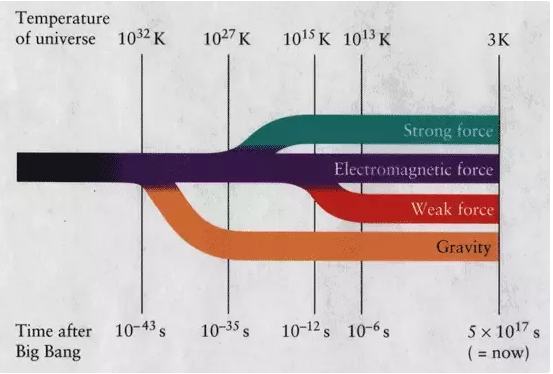
In rank order, gravity is the weakest of the fundamental forces. After that comes the weak nuclear force, then electromagnetism, and finally the strongest of the bunch is the strong nuclear force.
Gravity is responsible for keeping objects such as planets and asteroids orbiting around a central mass (such as the sun) and it makes objects fall to the ground. However as you journey from the macroscale to the microscale, gravity begins to become incredibly weak. On the atomic scale, gravity has almost no effect, and electromagnetism and the strong and weak nuclear forces take over. Gravity does not hold electrons to their electron orbitals around the nucleus, electromagnetism does. In this way, electromagnetism is much stronger than gravity. You can even prove this right now. Pick up your phone off your desk. Done? Congratulations, your small hand just beat the entire gravitational pull of the Earth. If the Earth could have it his way, your phone would remain grounded to the desk indefinitely, but you just overcame that with very little effort. Conversely, if you were to try to pull two magnets apart, it would require a little more effort.
Quick side note: scientists used to consider magnetism separate from electricity, but it was soon discovered that those are simply two variations of the same phenomena, and so together they became electromagnetism. Magnets affect the electric field and electricity affects the magnetic field. On a similar note, space and time were also discovered to be two sides of the same coin, and thus “spacetime” became modern nomenclature. The same occurred with mass and energy, which were directly proven to be equal to each other by Einstein’s famous equation: E=MC^2 (or in other words, energy = mass * the speed of light).

In field grids of this sort, vertical lines normally represent time and horizontal lines represent space; space and time are orthogonal to each other.
Returning back to bonded protons, electromagnetism suggests they should repel each other. But the strong nuclear force, a force an order of magnitude more powerful than electromagnetism, overpowers that repulsion and keeps the protons stuck to each other. The force only appears between nucleons and within the individual protons and neutrons–responsible for keeping quarks bonded together. In order for atoms to be pushed that close to each other, a very high energy density is required. The only way to achieve this is the nuclear fusion process that occurs in collapsing stars. Heavier elements with more protons require more input energy for the glue to stick, so they only form if the star is large enough.
The flip side of this is the weak nuclear force which enables atoms to split in a process called nuclear fission. I have found the best way to explain the relationship between the strong and weak nuclear is with an analogy. Imagine Joker and Batman are both on the top floor of a building. Batman and Joker are both very powerful and they represent protons that wish to repel each other. However, picture them tied together (against their will) by a very powerful rope (let’s say Wonder Woman’s Lasso of Truth). In this case, Wonder Woman’s rope represents the strong nuclear force, which despite Batman and Joker’s repulsion to each other, still keeps them bonded together. Now picture Robin suddenly bursting through a nearby window and removing the Lasso of Truth, allowing Batman and the Joker to separate once again. Robin represents the weak nuclear force, which is what enables atoms to split apart by separating the protons from each other.

This is the basis for nuclear weapons containing uranium where the uranium splits into two lesser elements, releases radiation, and 3 additional neutrons. Those 3 additional neutrons interact with 3 other uranium atoms, splitting them, releasing even more energy, and then each releasing another 3 neutrons (for a total of 9 free neutrons). The chain reaction continues to occur and the result is a mushroom cloud. The reason is because the strong nuclear force only works at small distances. By adding neutrons to an already heavy element, the atom becomes radioactive since the nucleus cannot hold them all together. The nucleus separates and releases electromagnetic radiation. Highly radioactive elements have more neutrons than they can support, so they decay more quickly and release greater swaths of energy.
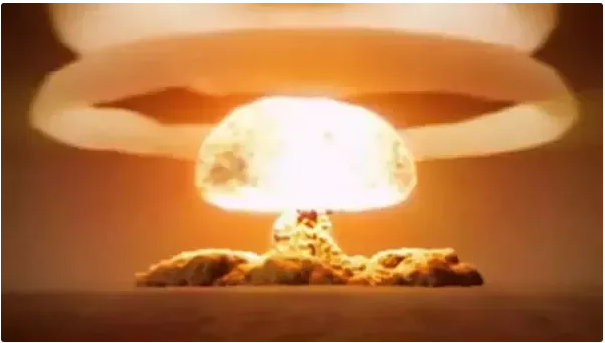
So as discussed earlier, isotopes are different versions of the same element that are created when you add or take away neutrons. Adding more and more neutrons will cause the atom to become radioactive and it will separate or decay into two separate lesser elements via the weak nuclear force. Many atoms have many different isotopes. Xenon and cesium have more isotopes than any other element with 36 respectively.
Uranium is the highest naturally occurring element in nature that we have discovered thus far with 92 protons. Elements higher than uranium on the bottom row of the periodic table (americium: 95, californium: 98, and einsteinium: 99) are manmade synthetic elements that have been created in particle accelerators. As you scale up the periodic table, the elements become more and more radioactive because they have so many more protons and neutrons in their nucleus that the strong nuclear force is not able to hold them. Elements exceeding 100 protons are incredibly difficult to keep together and decay in milliseconds, with the exception of elements that contain any of the even-numbered “magic numbers” of protons or neutrons. The magic numbers are 2, 8, 20, 28, 50, 82, and 126. If an element has any of those numbers of protons or neutrons, then it is magic and incredibly stable. If the element has any numbers from that list for both its protons and neutrons, then the element is “doubly magic” and especially resilient against decay. Nickel-78 is “doubly magic” because it has 28 protons and 50 neutrons.
Furthermore, there is a hypothetical “island of stability” (or “valley of stability ” for 3D models) in which certain isotopes (or versions) of the superheavy elements would remain bonded and never decay. The underlying assumption here is that there are elements that can potentially exist, but are not currently in the universe because there are no forces strong enough to fuse them. This has lead many chemists to predict the existence of hypothetic elements ranging from 119 to 218. Element 218 is a hypothetical noble gas known as Biunoctium. I am personally looking forward to the synthesis of computronium (programmable matter), though many people suspect it is really just unobtainium in disguise. In response to these elements, an extended periodic table has been created.
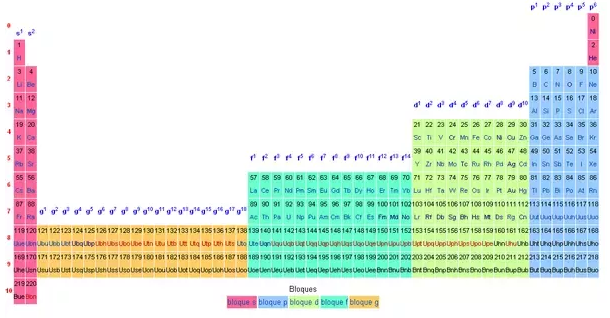
Currently, the Large Hadron Collider (LHC) is insufficient for producing these elements, but the proposed International Linear Collider, the High Luminosity Large Hadron Collider, or maybe even the Very Large Hadron Collider upgrade might be able to get the job done. The most recent additions to the periodic table were ununtrium (113), ununpentium (115), ununseptium (117) and ununoctium (118). In particular, ununpentium (literally translating to 115) seems to have a lot going for it. I am now entering into the realm of conspiracy and speculation, but I am hopeful you will at least find it worth the read. The following is not a reflection of my beliefs, but just something I find highly interesting and worth sharing. Bob Lazar, a person who has claimed to work in Area 51, claims there is an isotope of element 115 that amplifies the strong nuclear force in its atoms to generate a gravitational field. This gravitational field is capable of warping spacetime via spacetime compression in order to “exceed” the speed of light, not exceed in the sense of going faster than 300,000 km/h, but by warping the space around the ship to a speed that is not restrained by the speed of light (remember, the spacetime medium is not limited to the speed of light, only objects within it are. Therefore, this form of travel is technically possible, we just don’t know how to warp spacetime). The isotope of ununpentium responsible for this is obviously a “magic number” element with a whopping 184 neutrons.
Lazar claims he worked on a recovered alien ship that was made entirely of ununpentium and had these properties. Utilization of this element would not require hyper intelligence. He suggests the alien’s home world existed near a large star that was capable of producing the element naturally. If that is the case, one would not even need to be of human intelligence to make use of the element. Obviously this is a crackpot conspiracy theory of the most epic proportions, but I find the prospect of undiscovered elements or undiscovered isotopes of elements with magical properties very fascinating!
Additionally, NASA is in the process of developing a ship that would function very similarly to the ship described by Bob Lazar. It is called the Alcubierre drive and it would travel by contracting the space in front of it and expanding space behind it.
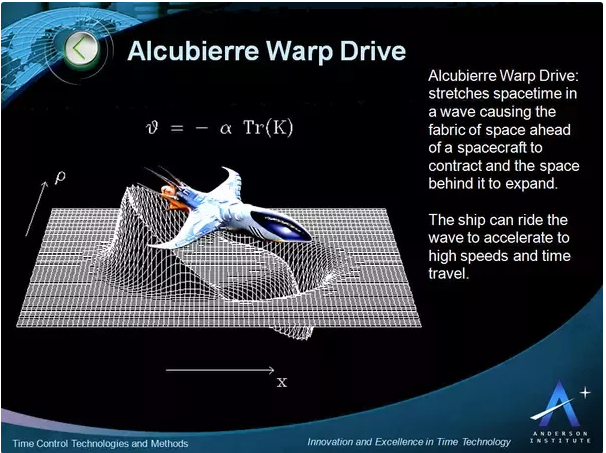
One final thing I would like to include on the elements and the human manipulation of atoms is an excerpt from WaitButWhy ’s piece on nanotechnology and artificial intelligence:
“Nanotechnology is our word for technology that deals with the manipulation of matter that’s between 1 and 100 nanometers in size. A nanometer is a billionth of a meter, or a millionth of a millimeter, and this 1-100 range encompasses viruses (100 nm across), DNA (10 nm wide), and things as small as large molecules like hemoglobin (5 nm) and medium molecules like glucose (1 nm). If/when we conquer nanotechnology, the next step will be the ability to manipulate individual atoms, which are only one order of magnitude smaller (~.1 nm).
To understand the challenge of humans trying to manipulate matter in that range, let’s take the same thing on a larger scale. The International Space Station is 268 mi (431 km) above the Earth. If humans were giants so large their heads reached up to the ISS, they’d be about 250,000 times bigger than they are now. If you make the 1nm – 100nm nanotech range 250,000 times bigger, you get .25mm – 2.5cm. So nanotechnology is the equivalent of a human giant as tall as the ISS figuring out how to carefully build intricate objects using materials between the size of a grain of sand and an eyeball. To reach the next level—manipulating individual atoms—the giant would have to carefully position objects that are 1/40th of a millimeter—so small normal-size humans would need a microscope to see them.”
The First Second
So with this underlying framework of atoms and their structure out of the way, we can now explore how the elements, solar system, and eventually the Earth were all formed. Perhaps you have a gold necklace around your neck. Or maybe your mother’s engagement ring is made of cubic zirconium. Regardless of the jewelry, these elements did not just randomly spawn on Earth. Their origin story is a lot more complex and interesting than that. I will begin with the events that followed immediately after the Big Bang.
So much occurred within the first second of the universe that it had to be broken into separate epochs, with each epoch getting its own unique name. It may even be the case that more events occurred within the first second of the universe than all of the events in all of the billions of years that followed.
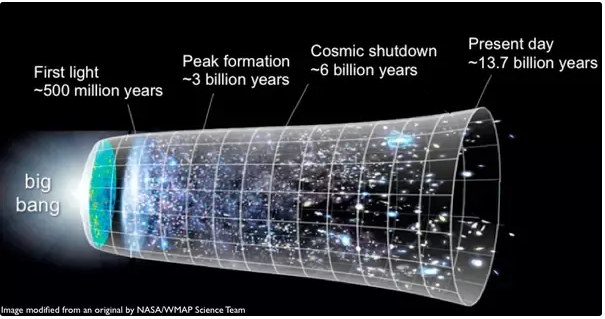
Before describing the stages of this single second, I will provide context on the various lengths of time that are smaller than seconds. The most obvious and well known examples are milliseconds, microseconds, and nanoseconds. Events on these timescales include the shutter speed of cameras, the blink of a human eye, and the fusion reaction of a hydrogen bomb. Shorter than that, you enter the realm of picoseconds and femtoseconds. On these scales, you will find the speed at which computers add integers, the oscillation period of a visible light wave, and the reaction time of pigments in your eyes to photons.
Smaller still, you reach attoseconds. This is the length of time it takes light to travel from one end of a dihydrogen molecule to the other end, the time it takes electrons to transfer between atoms, and it is the standard atomic unit of time. The shortest time interval ever recored was 12 attoseconds. Attoseconds are particularly interesting because a single attosecond is to a second what one second is to about 31.71 billion years. If you perceived life in attoseconds and lived up to a single second, it would be equivalent to living for over twice the age of the universe. Flash is said to perceive events in attoseconds (light appears frozen to him). Finally we reach the Planck time, which is the smallest meaningful length of time.
Before the formation of any elements, at the first passage of planck time (10^-43), the universe was condensed in a single point approaching one decillion (10^33) degrees in temperature. At this stage, all four of the fundamental forces were unified as one super force. A fraction of a second later, during the Grand Unification Epoch (10^-43 seconds to 10^-36 seconds), gravity separates from the other forces. Immediately after that, the strong nuclear force separates, causing the universe to expand from smaller than the size of a proton to the size of a grapefruit. This expansion is marked by the Inflationary Epoch.
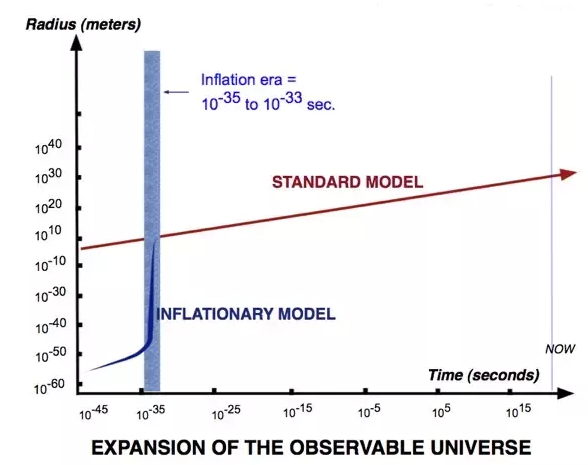
When the universe finally cools down to below 10 quadrillion degrees during the Quark Epoch (10^–12 seconds to 10^–6), quarks, antiquarks, and electrons form and the last of the fundamental forces separate so that there are now four. Antiquarks are the same as regular quarks, except that they have an opposite electric charge. Quarks and antiquarks were formed in equal numbers, and when they interacted with each other, they annihilated, creating energy. The matter that you and I are composed of though, only comes from quarks, not antiquarks. And yet, given the internecine relationship between these two particles, we technically should not exist at all. However, one quark in every billionth collision survived and those surviving quarks later created the matter you see today. This phenomenon, known as baryogengesis, is one of the great unsolved mysteries of the early universe. During the Hadron Epoch (10^–6 seconds to 1 second), the universe settles to only a trillion degrees in temperature, cool enough to allow quarks to form into protons and neutrons. All of that occurred within just the first second.
From that first second to the next 3 minutes, during the Lepton Epoch, leptons and anti-leptons (electrons and positrons) form most of the matter in the universe. When these particles collide, they also annihilate to produce photons. That was the first light of the universe. During Nucleosynthesis, occurring from the first 3 to 20 minutes, the universe cools down to around a billion degrees, which is cool enough to allow protons and neutrons to combine and produce the first nucleons of helium and hydrogen. However, the nuclear fusion halts after only 20 minutes because the universe quickly becomes too cool and voluminous for it to continue. Had it continued, its very likely those hydrogen and helium nucleons would have continued to fuse until they became iron, which would have prevented the formation of stars, galaxies, and life.
During the Photon Epoch (3 minutes to 240,000 years), all of the collisions between matter and anti matter (quarks-antiquarks, electrons-positrons) result in a substantial increase in the number of photons, making them the most ubiquitous particle in the universe. Despite this proliferation of photons, the universe is still opaque because the photons are quickly absorbed by free electrons.
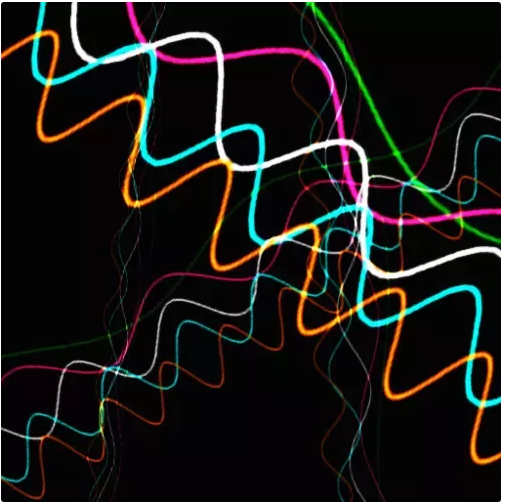
During Recombination (240,000 to 300,000 years), the temperature falls to 3,000 degrees (same temp as the sun), allowing ionized hydrogen and helium atoms to finally capture free electrons, thus neutralizing their charge and becoming the first atoms. The universe becomes 75% hydrogen and 25% helium. During the Dark Era (300,000 to 150 million years), when photons now have the ability to travel freely without fear of being absorbed, the universe is still mostly dark because there is no point source for the photons. They are just randomly scattered throughout the universe, as demonstrated by the Cosmic Microwave Radiation Background. The distance those wavelengths have traveled to us has caused them to elongate out of the visible light spectrum and into the microwave and radio wavelengths. That is what you are seeing when you come across images like these.
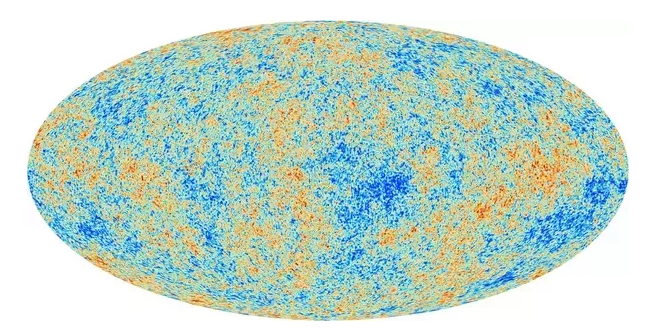
For the next 300-500 million years, stars and galaxies begin to form in large numbers. When the first generation of stars are born, they are short-lived and massive, composed of only hydrogen and helium. Remember, no other elements exist in the universe yet because the nuclear fusion that occurred during Nucleosynthesis did not last long enough to fuse heavier elements. This will be the role of the stars, not the universe. So continuing forward, the first stars are born and then they quickly die. As they burned through their energy reserves, hydrogen and helium began fusing together into heavier elements. If you recall from earlier, hydrogen has 1 proton and helium has 2 protons. When two helium atoms merge from the intense gravitational pressure of a collapsing star, a new atom with 4 protons is born, one we like to call beryllium. And so continues this process of proton addition via nuclear fusion to form higher elements such as carbon, oxygen, phosphorus, and sulfur. The elements produced extend all the way up to uranium (92 protons), which is the largest naturally occurring atom. The result is the formation of all the elements you see on the periodic table up to uranium.
Okay, so now we have our elements, but they are still trapped inside the centers of stars, so how do we release them out into the cosmos? Well, the stars still have one final job to do: self-destruct in a massive explosion called a supernova, thus casting their newly created material out into the far reaches of the universe.
Fast forward a few billion years and a star in our vicinity of the universe has just exploded into a large beautiful cloud of gas called a nebula.
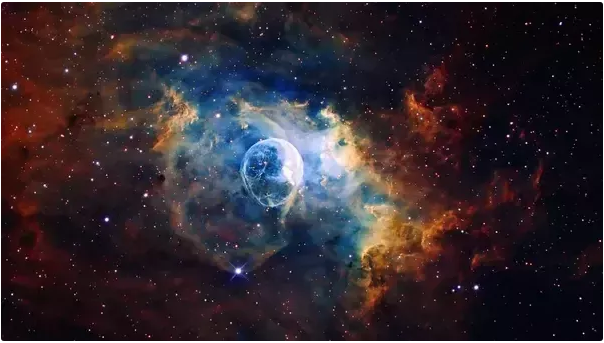
It is in these stellar nurseries where stars are born. The nebula that formed our solar system remained in this gaseous state for quite some time until some other nearby star exploded, causing ripples to travel through the gas cloud. The nearby explosion triggered gravitational collapse and the nebula collapsed into a disk. Microscopic particles began to collide and merge, forming tiny rocks called planetesimals. There were millions of these scattered throughout the solar system at first, but as they became larger, their increased gravitational attraction pulled other planetesimals to them becoming protoplanets. The collision and merger of multiple planetesimals formed larger bodies of rock and caused their gravity to increase even more rapidly, allowing them to attract even more planetesimals. At the heart of the collapsing nebula cloud where the force of gravity was most powerful, a protostar began to form. As the protostar began to contract further and further, it eventually became hot enough to fuse hydrogen, thus beginning its proper lifespan and becoming our sun.
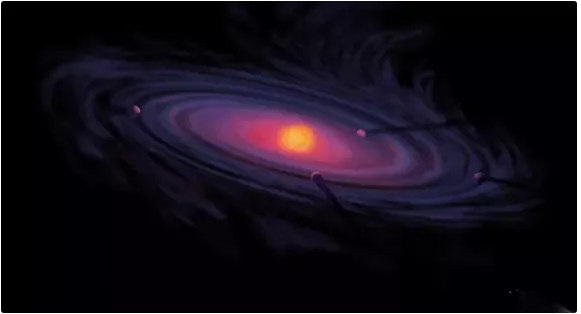
The early stages of the Solar System were very chaotic with numerous collisions and explosions, not the peaceful and stable system you see today. Those tiny clumps of matter became exponentially larger due to the cumulative effects of gravity, until eventually only four worlds remained: Mercury, Venus, Earth, and Mars. As you know, the four planets closest to the sun are rocky and the four outer planets are gaseous without surfaces. On Mercury, Venus, Earth, and Mars, there is a sharp transition from atmosphere to land, as opposed to Jupiter, Saturn, Uranus, and Neptune where it would be impossible to land a spacecraft because it would continue to fall through the planet until it reached their core. This is a result of the solar system’s early formation where only rocky, dense planetesimals could survive being near the sun’s heat. Moving farther away from the sun where it was much colder, the swirling ice and dust formed the outer four gas giants.

The moment the protosun and protoplanets were beginning to take their final forms into the solar system you see today, the sun ignited and gave off a huge blast of solar wind. This gust of radioactive energy blew away all the remaining dust and gas to the outer edges of solar system like a fan blowing out a smoky room. That outer shell is called the Oort Cloud. So all the asteroids and comets you hear about are nothing more than remnants from the early solar system, returning back from a time long ago.
Some astronomers suspect there was an early race between all the gas giants to become the sun. Of course, the sun won out by virtue of being in the center, technically making all the other gas giants failed stars. They never became large enough to combust hydrogen and so they hang their head in shame at the far reaches of the solar system. Evidence for this lies in the fact that all the gas giants have multiple moons making them their own little solar systems. Jupiter in particular has 63 moons! 60 orbit Saturn, 27 orbit Uranus, and 13 orbit Neptune. Jupiter was the closet to becoming a star, but never quite made the cut. Fortunately for us, Jupiter found a new job: Cosmic Defender of Planet Earth. Due to Jupiter’s size, its gravity is strong enough to sling long period comets out of the solar system before they even get a chance to reach Earth. If it wasn’t for Jupiter, there would be a lot more asteroid collisions on Earth, and Jupiter has the scars to prove it !
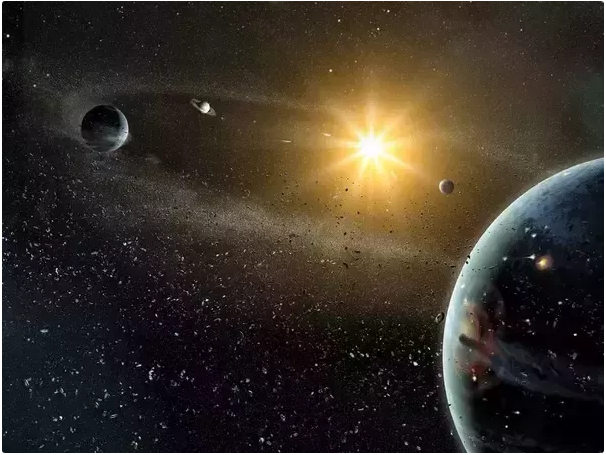
In ~5 billion years, the sun will exhaust its supply of hydrogen and helium and begin its transformation into red giant. The orbits of Mercury, Venus and Earth will all be consumed by the surface expansion of the sun (quick simulation here, and here is what the red giant will look like in the mornings, just before it engulfs the Earth). The goldilocks zone is the distance away from a star where planets are able to support liquid water. It is a zone where the temperature is not too hot and not too cold, allowing for the development of life. Currently, the Earth orbits just within the goldilocks zone, which is how you are able to be here and even read this. However, when the sun becomes a red giant, the goldilocks zone will shift to the moons of Jupiter and Saturn. The sun will remain a red giant for ~1 billion years until it becomes a white dwarf. So when life disappears from Earth, it may reappear on these moons. That is of course, if its not already there now. When the sun explodes, it will form a new nebula, laying down the groundwork for a new sun to emerge in the far distant future.
Consolidating the discussion to just Earth, I will now briefly describe its historic beginnings just before the sun hurled all asteroids and comets out to the outer reaches of the solar system. Before the Earth had a moon or life, it collided with a Mars sized planet named Theia. Theia hit the Earth moving at 15 kilometers per second, which is 20 times faster than a bullet. The impact caused the Earth to spin so fast that a single day was only 6 hours long. Here is a video of that collision: brace yourself, this one gets intense !
From the impact came a small chuck of rock that later became our moon, Luna. After the collision with Theia, Earth was even more hot and volcanic, and there was no oxygen atmosphere. A 20 million year period known as the Heavy Bombardment maintained these conditions for a significant length of time where asteroids continuously bombarded the Earth. The craters on the moon are evidence for this event. Additionally, these asteroids were ultimately what broke up the Earth’s initial crust, causing it to divide into the tectonic plates that carry the continents today.

Nearing the end of this event, volcanic steam mixed with water vapor rose into the atmosphere, condensing into clouds, and then came down as acid rain. The rain eroded and filled large ravines in the Earth’s surface, thus forming the Earth’s oceans. You heard that right, the Earth’s oceans first formed in the sky. Comets carrying salt and tiny droplets of water also contributed to their formation. The salt in the comets as well as the salt released from the eroded rocks is the reason why the oceans are mostly salty today.
For the moment, I feel it is worth elaborating on volcanoes. Volcanoes are the most destructive forces on Earth, and the threat of their cataclysmic potential still looms heavily over humanity’s head from below. Here is an image of Mount Pinatubo, the largest volcanic eruption in the last 100 years:
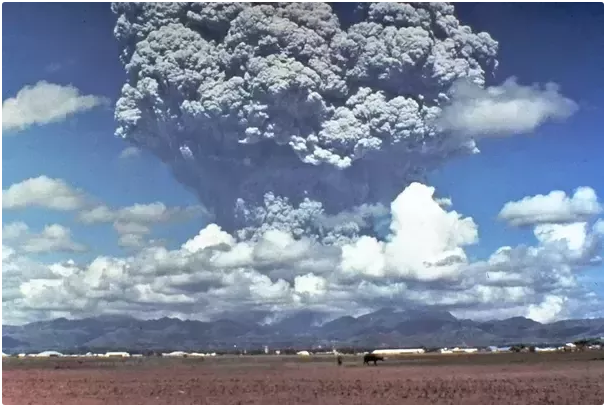
Hundreds of people died despite successful evacuations occurring days in advance.
Humans have the least genetic diversity–relative to population size, of any other animal on Earth. Scientists have concluded that this was due to the Eruption of Mount Toba, which left a bottleneck effect on humanity, leaving only a few thousand survivors. Only a small percentage of humans survived that catastrophe, meaning you and everyone else are all decedents of that tiny gene pool.
Yellowstone, a super volcano in Wyoming, may be the next major threat to humanity. Super volcanoes are different from regular volcanoes in that they are not triangular shaped mountains that are visible from a distance, but are instead large depressions in the Earth called calderas. Instead of magma rising and bursting at the top of volcanos like in small volcanos, in super volcanoes, magma rises to fill underground reservoirs, and then explode the ground after thousands of years. No one knew where the yellowstone caldera was until we went into space. A satellite image revealed that we couldn’t locate it because we were standing on it; the entire park was one great big caldera with magma just below its surface!
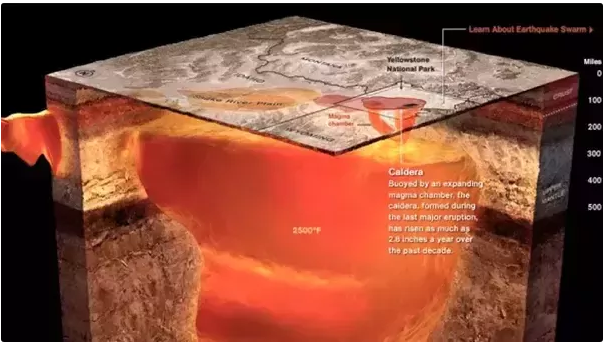
That is enough magma to fill the grand canyon 11 times. Conversely, pooling the entire human race together would not come anywhere close to filling the grand canyon even once.
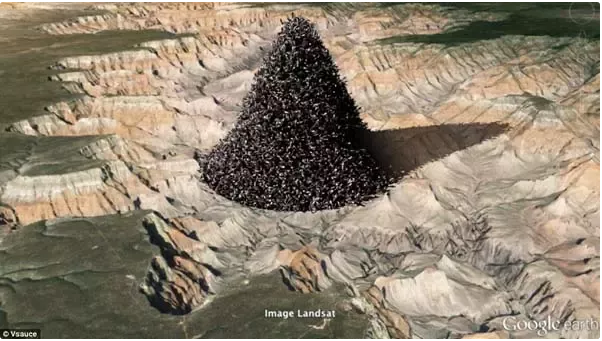
In the very first image above, you saw the plume cloud of Mount Pinatubo in 1991. The eruption of Yellowstone will be upwards of 200 times that size if the past is any indication. For comparison, the sun is 109 times the diameter of the Earth.
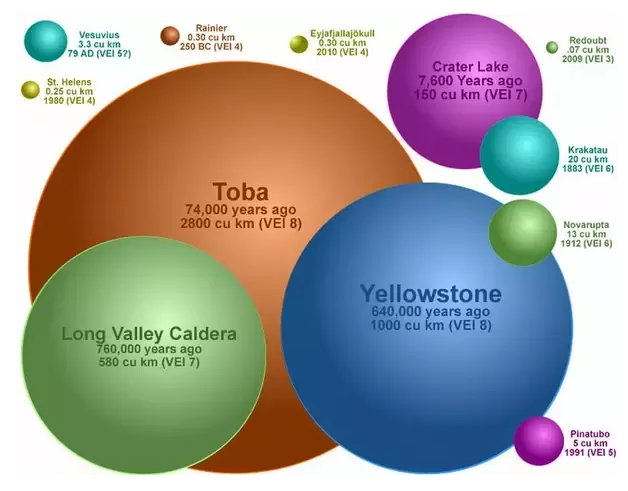
Mount Pinatubo is the tiny purple circle. Yellowstone is the giant blue circle.
The worst part of this is that Yellowstone is past due for eruption. Yellowstone erupts, on average, every 600,000 years, and the last time it erupted was 640,000 years ago. That means the volcano is 40,000 years past its expiration date. We are sitting on a time bomb. When Yellowstone erupts, it will be the loudest sound heard by man in 75,000 years. The effects will not just be catastrophic for America, but for the entire world. This is why I feel politicians should not be so hard on immigrates. If Yellowstone erupts anytime soon, there may be millions of American immigrants trying to flee into Mexico and other nearby countries, and that would be a terrible irony. Here is the estimated blast radius.
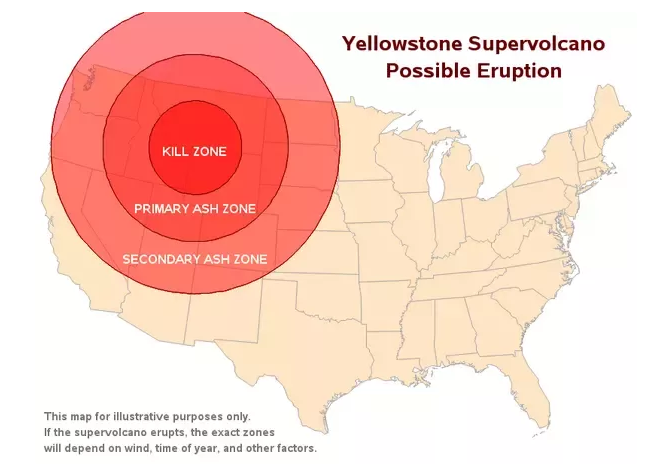
Venturing back into space, there may have been volcanic eruptions on the moon perhaps as early as the time of the dinosaurs. Venus has thousands of volcanoes including the shield volcano Maat Mons.
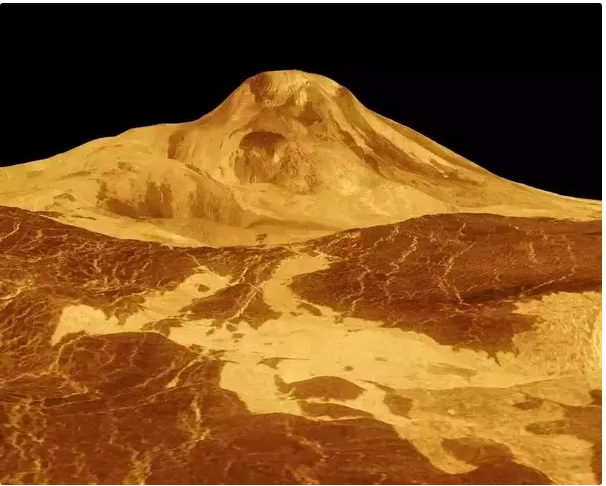
The largest volcano in the solar system is Olympus Mons, which is about the size of Italy. Located on Mars, Olympus Mons has been the subject of travel posters created by the incredibly awesome aerospace company SpaceX. Exploring Olympus Mons will be one of several things the first humans will be able to do once SpaceX gets them up there in the Mars Colonial Transporter.

Size comparison between Olympus Mons and Mount Everest.
One possible solution to the mystery of how life began at the bottoms of the ocean near the hydrothermal vents is that life actually began on Mars, where through a process called panspermia, martian microbes came to Earth encased in meteorites. After all, Mars may have at one point been a better place for the formation of life. In fact, 4 billion years ago, half a billion years prior to the development of life on Earth, mars looked like this:
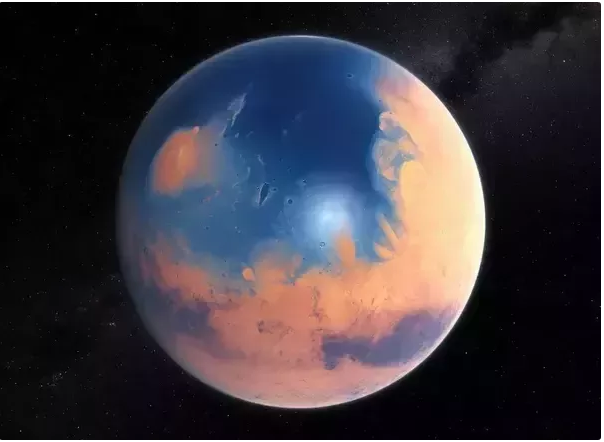
and this:
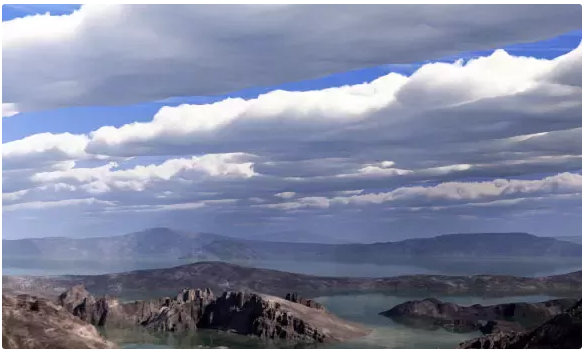
From NASA Goddard Conceptual Image Lab
Complete with blue skies, clouds, and flowing water. Perhaps if Elon Musk’s company spaceX gets the first human colony to Mars, it will just be humanity returning to its home planet; its initial place of origin. Even more surprising is that Mars’ sky turns blue during sunset/sunrise and red during the day, which is the complete opposite of how it works on Earth.
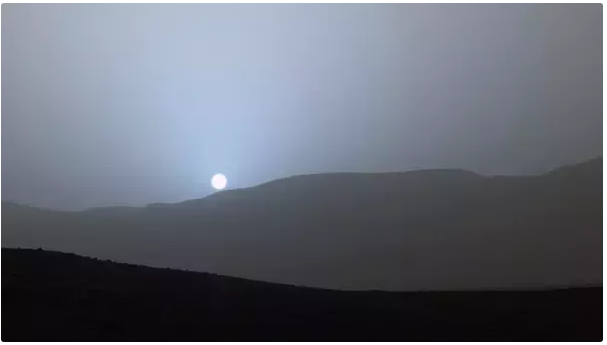
Bonus. String Theory and the Multiverse
Disclaimer: String Theory is part of theoretical physics therefore much of the following will be based on theory rather than verifiable empirical data. Despite this, I still think it is worth discussing here if for no other reason than to just ponder the possibilities.
As mentioned earlier, there are four fundamental forces that govern the universe. At the big bang, those forces were united as one principle force, but they later separated as the universe continued in its expansion. Many theoretical physicists suspect there is a way to describe them with one unified theory. The two biggest contenders are String Theory and Loop Quantum Gravity. I know very little of LQG, so my explanation will focus primarily on String Theory.
Quantum Mechanics describes three of the fundamental forces pretty thoroughly. For the strong nuclear force there is quantum chromodynamics and for electromagnetism and the weak nuclear force there is the electroweak interaction. Similarly, general relativity does a good job with describing gravity. Simply put, quantum mechanics describes how the universe works on the small scale and general relativity describes how the universe works on the large scale. Together, these two theories explain nearly everything. The issue here is that they are incompatible with each other. The way things work on the quantum level is not how things work on the macrolevel, and vice versa. The equations of gravity cannot be applied to particles at the atomic level. This is mainly due to the fact that the graviton has continued to remain undiscovered. All the other forces have force-carrying particles that describe their behavior: electromagnetism=photons, weak nuclear force=W & Z bosons, and the strong nuclear force=gluons. But as it stands, gravitons have not been proven to exist, even with the recent detection of gravitational waves in which the graviton should be the particle that propagates those waves.

Additionally, there are certain things in the universe where it is unclear which theory should be unitized to describe it. Take blackholes for example. Do you use quantum mechanics (a description of the small scale) since the primordial black holes likely existed at the quantum level and the singularity of a black hole is a single point in spacetime, or do you use general relativity (a description of the large scale) to describe them since they possess enormous mass and gravitational attraction? Well in this instance, it only makes sense to use both. However when one does this, physics stops working; it breaks down at the singularity where predictions reach infinitely.
Enter String Theory. String Theory was created to bridge the gap between Quantum Mechanics and General Relativity. By doing this, it would successfully describe the properties of blackholes in one equation. It would also solve the little issue concerning the Big Bang. Newton’s first law of thermodynamics states that energy cannot be created nor destroyed, and yet the Big Bang appears to violate this axiom outright. String Theory also attempts to solve the mystery of dark matter and dark energy by supposing that the universe is layered like a sandwich with two planes of reality. It treats stars and galaxies as one type of matter on this plane and dark matter as a different type of matter on the second plane. Only gravity is transferable between the two planes, which would explain why dark matter only affects the gravity of galaxies, but doesn’t interact with any other forces. If String Theory is ever verified, it will succeed in it’s quest to be the Theory of Everything. This quest was first pursued by Albert Einstein after he derived Special Relativity and later General Relativity, and has since been taken up by Stephen Hawking, Michio Kaku, Brian Greene, and Leonard Susskind.
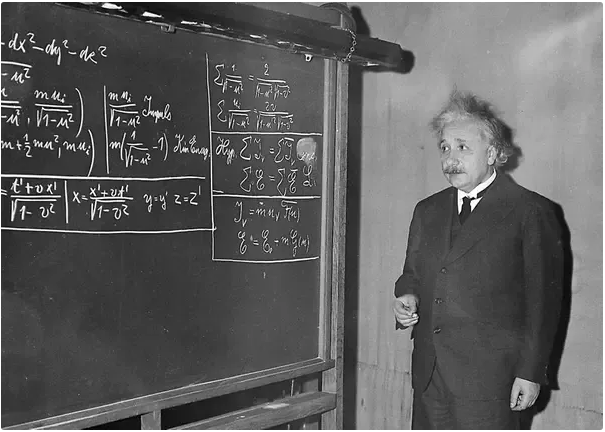
String Theory essentially postulates that on the smallest sub-sub-atomic scales there exists tiny vibrating strings that are bundled into quarks. The strings are so small that if you scaled an atom to the size of the solar system, a single string would be the size of a tree on Earth. There are an infinite number of these strings that vibrate at various frequencies to produce their own type of particle. So far, only 17 particles have been discovered within the Standard Model. This means that with an infinite variation of strings, there are particles hidden in our reality that we may never discover. One slightly misleading analogy is to consider how different strings on a guitar produce different variations of sound.
In order for String Theory to work, three things must be true.
1. The multiverse. In order for the math to work (which I don’t quite understand) there must be an infinite number of universes.
2. There must be at least eleven total dimensions: six that are spatial and one that is temporal. Higher dimensions will be layered over lower ones.
3. White holes.

The multiverse
Originally, we thought there was only one planet, then we learned there were eight. We thought there was only one sun, then we learned there were 100 billion. We thought there was only one galaxy, now we know there are 100 billion galaxies. Given our track record, why should we assume there is only one universe? One useful analogy is to picture blowing bubbles in a bathroom. Each bubble (called a brane) represents an individual universe. Different universes do not exist in each bubble, but rather on their surface. Another analogy is that the multiverse is like a fish tank and random big bangs occur throughout the water. As each universe expands they get closer to each other. However by the time they do collide, both universes will have died of the Heat Death (Big Chill). At the point of their collision, a new big bang forms, creating an entirely new universe.
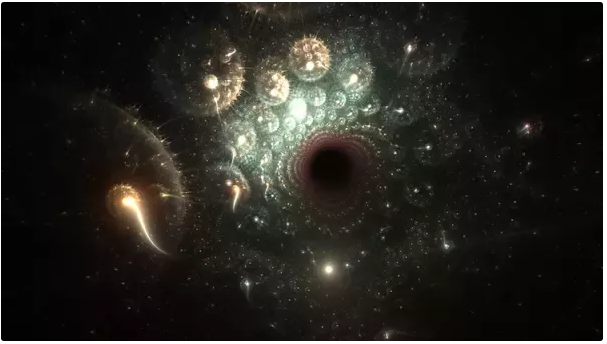
Under the many-worlds interpretation of quantum mechanics, there is a universe that accounts for all possible outcomes for every possible event. If you approach an intersection and go right in one universe, in another universe you will go straight, and in another you will turn left. The differences can be incredibly minute too; in some cases, the only difference between two universes will be a single blade of grass on your front lawn. This theory serves as a counterpoint to the proposition in quantum mechanics that a wave function collapses into one of several possible quantum states upon observation. Particles, when unobserved, exist in a superposition, which means they exist in all possible quantum states. However, when you measure a particle such as an electron, it seems to decohere, or to choose a single state. The many world interpretations says each possible state of the particle is chosen in a separate universe where the measurements take place. The idea is best explained by quantum suicide, in which despite holding and shooting a loaded gun to your face, there will be some universe where the gun will not go off to account for all possible outcomes. That version of you will have reached quantum immortality.

11 dimensions
The second condition of String Theory assumes the existence of 10 spatial dimensions with the 11th dimension as time. As humans, we experience three spatial dimensions (width, height, and depth) and one temporal dimension in the form of time. However, we only perceive things in two dimensions. If we really did see in three dimensions, we would be able to see behind and inside objects such as cubes (your tv, drawer, refrigerator, etc.), square pyramids (egyptian pyramids, transamerica building in San Francisco, etc.), and cylinders (batteries, cans of vegetables, and trees). Furthermore, as noted in this video, if you were to watch a floating ball grow proportional to the distance it was moving away from you, you would not perceive any changes in the distance or size of the ball.

With that in mind, I think it’s important to clarify what a dimension actually is.
Suppose you are attempting to locate the Marriott Marquis hotel in Manhattan where you have agreed to meet a friend. In order for you to find this hotel on a map, you need two significant pieces of information: the street name and the avenue.
Slightly off topic but still related, road names such as street, avenue, boulevard, lane, drive, and way have very specific conditions that a road must adhere to in order to be labeled with that term. F.ex, a boulevard is a road with trees down the middle or with trees on both sides, while a lane is a narrow road without a medium. In the example above, a street is what connects buildings together in a city, and usually flow from east to west (horizontal) on a map. Avenues are streets that flow from north to south (vertical).
Once you have these two pieces of information, which is the corner of 7th avenue and 46th street in the case of the Marriott Marquis, you are essentially operating in two dimensions. Now suppose you are meeting your friend at his room on the 3rd floor once you reach the hotel. You have just added a third piece of information, a third dimension (height) used to reach a more specific location in spacetime. To go even further, you have arranged to meet him there at 4 pm. It has now taken 4 pieces of information, or dimensions, in order to successfully meet your friend: three spatial dimensions and one temporal dimension. As you can see, with each successive dimension, your location in spacetime becomes more and more precise. Higher dimensions, as proposed by String Theory, simply increase your specificity in spacetime. It is difficult to imagine the properties of higher dimensions in the same way it would be difficult for a flatlander to imagine the third dimension. Despite this, String Theory postulates that dimensions 4 onwards are incredibly tiny and undetectable to us. They are so tiny in fact, that only particles are capable of perceiving them.
To illustrate this, picture yourself standing on a sidewalk, gazing directly across the street at a telephone wire that is running perpendicular to your line of sight.

From your vantage point, you are only seeing the telephone wire in 2 dimensions. You see nothing more than a black line stretching from pole to pole.
Now picture an ant crawling over the surface of the very telephone wire you are observing.

The ant is able to see that wire in 3 dimensions. From the perspective of the ant, that wire has width, height, and depth. It can observe the curvature of the wire and even circle around it in 360 degrees.
However you are staring at that ant across the street, and you are only seeing the telephone wire in 2 dimensions. Yet within your own two dimensional field of view, there is a third dimension that you cannot observe. The third dimension is hidden along the two dimensional wire, right there in front of you! This is the idea with higher dimensions in string theory. They exist all around us, but are inaccessible except to atoms. The way that ant’s perspective of the wire compares to you is the way the atom’s perspective compares to humans.
White holes
The final thing string theory assumes the existence of is white holes, which as you may or may not have guessed, are the opposite of blackholes. Blackholes are regions in space where nothing can escape their pull of gravity. Getting caught near a blackhole will prevent you from escaping its gravity if you are unlucky enough to cross its event horizon, otherwise known as the point of no return. If you were to cross the event horizon, you would become essentially erased from universe, with no hope of ever returning. Even if you somehow survived the journey, you would still longer exist, at least not in this universe, because you would never be able to come back out. Interestingly enough, some scientists have suggested that hyper advanced alien civilizations may actually go to live near the center of blackholes as there may exist a region just before the singularity where orbits are stable and the singularity could supply near infinite reserves of energy. It is suspected to be relatively peaceful there, and this is compounded with the fact that blackholes will out live any other object in the universe. And if these creatures had technology capable of modeling the future, in the same way we use computer models and simulations to study the big bang and early universe, then those aliens would have no reason to leave. They would already know what the outcome of the universe is. This is one possible explanation for the fermi paradox.
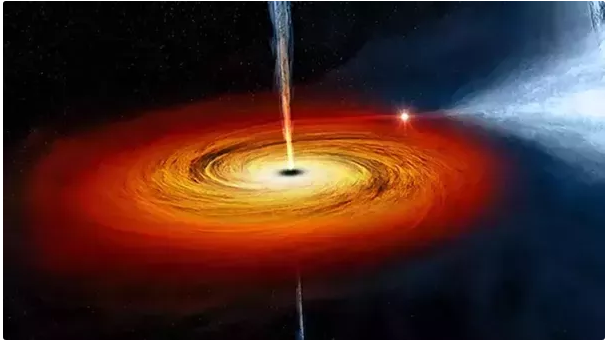
Just as blackholes are things you can never escape, white holes are things you can never enter, because they are constantly shooting matter outward. A good way to keep this straight is to think of blackholes as cosmic vacuums and white holes as cosmic leaf blowers. Many theoretical physicists think white holes are formed from blackholes nearing the end of their lifespan. Proponents of loop quantum gravity suggest that late stage blackholes eventually explode, releasing all of its captured matter back out into the universe, thus becoming a white hole. Through this lens, the big bang was a kind of supermassive white hole. The amount of ejected matter will be identical to the amount of matter that was consumed. This coincides nicely with Stephen Hawking’s solution to the information paradox.
Blackholes store everything they consume, it’s just that the information gets scrambled. But if you were to take each particle of a single object out of a blackhole, one at a time, you could theoretically reassemble that item. Its similar to a kitchen blender. If you write down your name on a sheet of paper and put it in a blender, the information is still there, the paper and graphite do not disappear, they just get ripped into tiny shreds.
Even more fascinating is that white holes and black holes may be linked by a quantum conduit, and white holes may exist in other parts of the universe, or within other universes entirely! The implications of this are that if we somehow discover a way to enter blackholes safely, we should in theory, exit out of a white hole in some distant part of our own universe, or potentially within another universe. Tread carefully though; universe hoping is a dangerous game to play because we will be unaware of how the laws of physics differ in other universes. The multiverse supposedly accounts for all possible events and scenarios. If this is true, then in some universes, certain atoms may not have formed yet to enable life, or in others, gravity could be much stronger than it is in our own universe. Upon exiting the white hole, the new universe’s gravity could immediately slam us to the surface of our ship with forces similar to neutron stars. What’s more, there may be some universes without any stars at all, just a sea of unbonded particles. In such a scenario, how would we obtain energy? Assuming humans are still humans at this point and not transbiological organisms, how would we acquire nutrients such as protein and calcium. The molecular assembler, a device capable of alternating atoms in such a way that wood can become gold, may be one solution, but this assumes atoms will still bond the same way, or even at all.
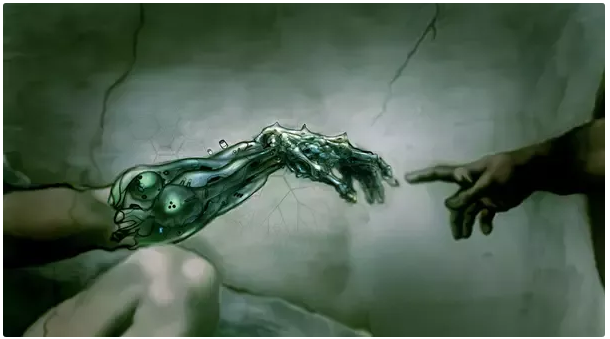
Now the question becomes how do we enter blackholes and, you know, survive. By attempting to enter smaller, stellar mass blackholes, your death will most certainly be labeled as a “suicide by blackhole” in the obituary. However, you might be better off in attempting to enter supermassive blackholes. Based on the mathematics of blackholes, this seems to be the first parameter that must be met in order explore the multiverse. If you recall from earlier, these behemoths work in concert with dark matter to hold galaxies together. The largest among them could swallow our solar system a few times over–and yet, they may not be as dangerous as you might think. Every blackhole contains an event horizon that varies in size relative to the blackhole’s size. The event horizon of small stellar mass black holes is usually about the size of the blackhole itself. However, when you double the mass of a blackhole, the size of the event horizon also doubles, but the volume of the black hole triples, which is a feature of the square-cubed law (a law that prevents the existence of giant humans ). This phenomenon enables supermassive blackholes to have much smaller event horizons relative to their size than stellar mass blackholes do relative to their size. Consequently, supermassive blackholes treat you much nicer on your decent towards the singularity than smaller, stellar mass black holes do. Comparing a supermassive black hole to a stellar mass blackhole is like comparing a giant teddy bear to a savage chihuahua. You will travel a significant distance in the supermassive blackhole before you start to experience any real harm. This method assumes there are certain trajectories you can enter blackholes that allow you to bypass the event horizon and still travel to distant parts of the universe or new universes’ entirely.
More favorably, the supermassive blackhole should be a Kerr blackhole. Instead of the singularity of this type of blackhole being a single point at the bottom of a massive gravity well, the singularity of a Kerr black hole is a ring.
Take this excerpt from an io9 article:
"Ever spun a glass of water, or soda bottle, so that the liquid inside swirls? Sometimes, if you spin it enough, the liquid actually parts, leaving a clear center and a spinning ring of water around it. The same kind of thing can happen in Kerr black holes. Instead of a singularity at the center, there's a ring. And you can go through the open portion of that ring without touching the gravitational crush.”
Upon crossing the event horizon, the inner Cauchy horizon should contract like a wringed towel as it falls through the ring singularity and then reopen on the other side, launching all matter that came with it through a white hole.

The risky and dangerous venture of entering blackholes will become a worthy one for the simple fact that the universe will soon come to an end in an event known as the Big Chill. As I mentioned at the outset, the universe is expanding by the forces of dark energy and instead of slowing down, this expansion is actually accelerating. At some point in the distant future, every thing will drift away from everything else. The moon is drifting away from the Earth at approximately 3 centimeters per year, and soon solar eclipses will no longer be possible because the moon will not be large enough to block out the sun. On a larger scale this is happening between galaxies and galactic superclusters. The end result will be large separation on the quantum scale. Atoms will no longer be capable of forming molecules because the distance between them will be too great. In the late stages of the Big Chill, hydrogen and oxygen atoms will not be capable of forming water because those particles will be separated by vast distances. This means no organic life, no planets, no stars, and no galaxies. Heat is generated by the collisions of atoms and molecules. However, when atoms become far enough away from each other, the amount of collisions will decline, and as a result, the universe will become colder (hence Big Chill).
Before I proceed with a final description of the end, I will provide you with one possible explanation of the beginning. It is known as the cyclic model of the universe and it posits that the universe is actually part of an eternal series of oscillations between the formation and destruction of the universe. Picture two sheets of paper floating just 3 centimeters away from each other. These represent two planes of reality and they are repelled by the heat of the universe. Returning back to the Big Chill, as the galaxies, stars, and eventually atoms continue to separate due to dark energy, the heat will begin to dissipate, and those two sheets will start to inch closer to each other. Blackholes have a longer lifespan than any other object in the universe and they will be the last objects remaining during the Big Chill. With no surrounding matter to grow in size, the blackholes will emit hawking radiation and eventually evaporate. When the last remaining blackhole evaporates, which signifies the last bit of heat energy left in the universe, time will freeze (there will be no events occurring), and those two sheets of paper will collide, producing another big bang.
The implications of this theory are that you have read this answer many times before in the past, and you will continue to do so in the future with each death and birth of the universe. Perhaps you have been sitting in that chair you’re in now millions of times before in previous iterations of the universe.
Here is a great short story on the end of the universe by Isaac Asimov entitled: The Last Question

Other interesting facts:
- Some scientists suspect the WAMP Coldspot, which is the largest supervoid discovered thus far, is evidence for the multiverse. That may be the location in which another universe is pushing up against our own, causing all the matter (and dark matter/energy) to be pushed outward.
- Our solar system may be a binary star system (most are [1]). Scientists such as Richard Muller have proposed the existence of a brown drawf star dubbed Nemesis that orbits the sun somewhere in the Oort Cloud. They have attributed all of the periodic mass extinctions throughout Earth's history to the evildoings of Nemesis. At some point in its orbital path, Nemesis enters deep into the Oort Cloud and its gravity causes asteroids to fly toward the inner solar system. It is also thought that Nemesis may also be responsible for Sedna's massive aphelion.
- Something massive is pulling us and all other galaxies toward a location called the Great Attractor. However, something even larger is pulling that, but we cannot observe either one because they are both hidden behind the Zone of Avoidance.
- The Hercules–Corona Borealis Great Wall is the largest object in the observable universe. It is so massive that astronomers claim it shouldn't even exist at all.
- A googol is the number 1 with a hundred zeros after it. A googolplex is one with a thousand zeros after it, and a googolplexian is one with a million zeros after it. The ladder numbers do not add further interest, so I will focus on a googol, expressed as 10^100. If the universe is a googol (10^100) meters in length, and you were to travel far enough, you would eventually begin to see duplicates of planets, galaxies, and then eventually yourself! This is because the number of possible arrangements in a given volume for the total amount of atoms in the universe (10^70) would run out long before you reached the distance of a googol. See numberphile's video for a more indepth explanation. Also, here is what will happen in the universe 1 googol years from now.
- The nucleus of an atom is incredibly tiny relative to the probability cloud of the electrons. A useful analogy is to imagine a green pea at the center of a gothic cathedral. Expanding on the notion of size, the width of an average human hair is about one million atoms. Next time you are holding a strand of hair, realize that you are viewing approximately one million atoms! In reference to neutron stars, picture filling that cathedral to the brim with green peas, then combine those green pea-filled cathedrals until you have something the size of a city. That is a neutron star.
- The pyramids were built 4,000 years ago, but they were also built lightyears away due to the fact that the Earth orbits the sun, and the sun orbits the supermassive blackhole at the center of the Milky Way. We have traveled a great distance from that initial location where the pyramids were built.
- You can explore much more of the universe by going smaller instead of going larger: Scale of the Universe. On the smallest scales, quantum foam and the strings of String Theory are estimated to exist on the Planck length which is 10^-35. Conversely, the Observable Universe, estimated to be 92 billion light-years in diameter, is only 10^27.
- Most people's intuitions about where we are in the cosmos stops at Pluto. However, past Pluto, and encasing the entire Solar system, is a sphere of rocks called the Oort Cloud.
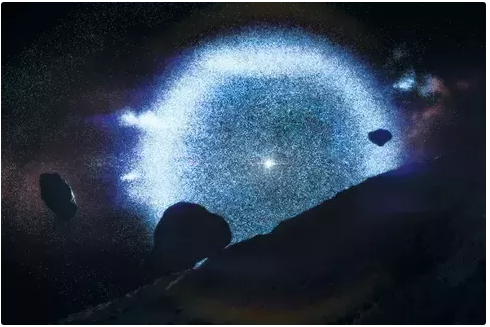
Venturing past the Heliosphere, Heliopause, the Heliosheath, and finally Bow Shock,
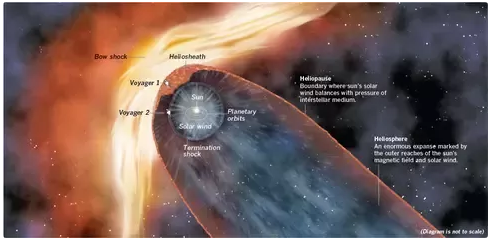
we see that our closest stellar neighbors are the three stars in the Alpha Centauri star system at ~4.24 lightyears away.
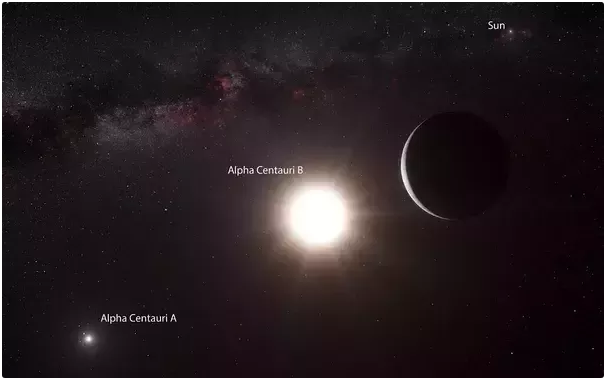
Our solar system (in the inner sphere two images above) orbits around the Milky Way every 230 million years in the Orion arm (in the image below).
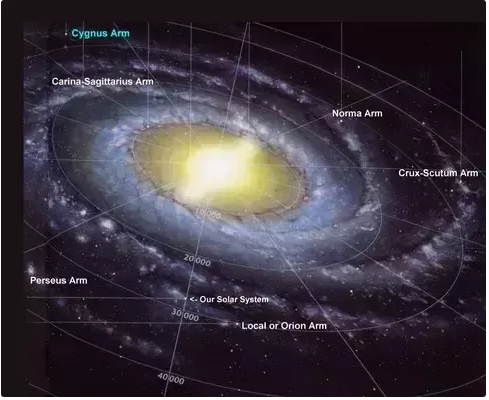
Next to the Milky Way is the Andromeda Galaxy and the Triangulum Galaxy, as well as the Large and Small Magellanic Clouds.

Here is the impending collision scenario.

- So you may have heard that the common ancestor of humans lived in arboreal, there was a food shortage, and then half of our common ancestor remained in the trees, and the other half left the trees in search of more food. The ones that left later evolved to become humans and the ones that remained evolved to become apes. We began to walk more upright as we explored the open plains and grasslands, and running become more important for us to capture food. Our quadriceps became larger and stronger as a result and we lost most of our hair so that we could sweat more easily. Apes retained their hair since it kept them warm at night and the trees provided shade during the day. I bring this up to mention a theory of cosmological natural selection proposed by the physicist Lee Smolin. The theory supposes that with each blackhole that forms, a new universe is created within it, and each of these new universes contain slightly different variations of the fundamental forces. Only the universes with conditions that are most conducive to the birth of new stars will in turn give rise to their own blackholes from star collapses, and natural selection will begin to favor that route of cosmic evolution. The interesting thing to note here is that the principles of evolution and natural selection may not just exist in the sole domain of biology, but may be a fundamental principle that governs the workings of the universe.
- The weatherman lied to you this morning when we he mentioned something about a sunrise and sunset. The sun does not move at all relative to the position of the planets. Instead, the Earth spins about its axis and the sun gradually comes into view. The same process applies to a galaxy rise, in which you can watch the Milky Way band rise overhead in a dark location such as the Grand Canyon.
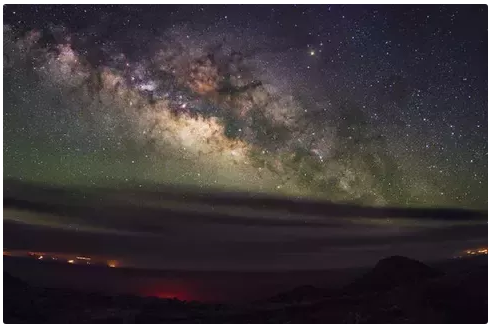
I know this answer was long. If there is any information here that you feel does not add to the quality of the answer, please leave a comment.
If you enjoyed this and wish to read further science lore, I recommend you explore the site futuretimeline.net .
Sources:





















